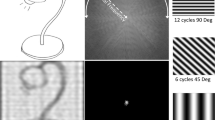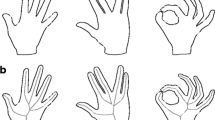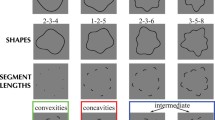Abstract
This paper reviews recent psychophysical methods that have been developed for measuring the perceived shape of objects. We discuss two types of shape ambiguities that exist for many objects — a depth reversal ambiguity and an affine ambiguity. We show that people perceptually resolve these shape ambiguities by making strong prior assumptions the object.
Access this chapter
Tax calculation will be finalised at checkout
Purchases are for personal use only
Preview
Unable to display preview. Download preview PDF.
Similar content being viewed by others
References
K. Berbaum, T. Bever, and C.S. Chung. Extending the perception of shape from known to unknown shading. Perception, 13:479–488, 1984.
P. Belhumeur, D. Kriegman, and A. Yuille. The bas-relief ambiguity. In Proceedings of the IEEE Conference on Computer Vision and Pattern Recognition, pages 1060–1066, San Juan, Puerto Rico, June 1997.
H. Bülthoff and H. Mallot. Interaction of depth modules: Stereo and shading. Journal of the Optical Society of America, 5:1749–1758, 1988.
H. Bülthoff and H. Mallot. AI and the eye, chapter Integration of stereo, shading, and texture, pages 119–146. Wiley, 1990.
D. Brewster. On the optical illusion of the conversion of cameos into intaglios and of intaglios into cameos, with an account of other analogous phenomena. Edinburgh Journal of Science, 4:99–108, 1826.
V. Blanz and T. Vetter. Morphable model for the synthesis of 3d faces. In SIGGRAPH Conference Proceedings, pages 187–194, 1999.
C. G. Christou and J. J. Koenderink. Light source dependence in shape from shading. Vision Research, 37(11):1441–1449, 1997.
R. Erens, A. Kappers, and J. J. Koenderink. Perception of local shape from shading. Perception and Psychophysics, 54(2):145–156, 1993.
R. Gregory. The Intelligent Eye. MacGraw-Hill, New York, 1970.
H. Hill and V. Bruce. Independent effects of lighting, orientation, and stereopsis on the hollow-face illusion. Perception, 22:887–897, 1993.
J. J. Koenderink, A. M. L. Kappers, J. T. Todd, J. F. Norman, and F. Philips. Surface range and attitude probing in stereoscopically presented dynamic scenes. Journal of Experimental Psychology: Human Perception and Performance, 22:869–878, 1996.
D. Kersten, P. Mamassian, and D. C. Knill. Moving cast shadows induce apparent motion in depth. Perception, 26(2):171–192, 1997.
J. J. Koenderink, A. J. van Doom, C. Christou, and J. S. Lappin. Perturbation study of shading in pictures. Perception, 25(9): 1009–1026, 1996.
J. Koenderink, A. van Doom, and A. Kappers. Surface perception in pictures. Perception and Psychophysics, 52(5):487–496, 1992.
J. J. Koenderink, A. J. van Doom, and A. M. L. Kappers. Pictorial surface attitude and local depth comparisons. Perception and Psychophysics, 1996.
M. S. Langer and H. H. Bülthoff. Depth discrimination from shading under diffuse lighting. Perception, 2000 (in press).
M. Luckiesh. Light and shade and their applications. Van Nostrand, 1st edition edition, 1916.
M. Langer and S. Zucker. Shape-from-shading on a cloudy day. Journal of the Optical Society of America A, 11(2):467–478, 1994.
P. Mamassian, D. Kersten, and D. Knill. Categorical local-shape perception. Perception, 25:95–107, 1996.
P. Mamassian, M. S. Landy, and L. T. Maloney. Global shape and surface orientation. Investigative Ophthalmology and Visual Science, 1997.
E. Mingolla and J. Todd. Perception of solid shape from shading. Biological Cybernetics, 53:137–151, 1986.
J. F. Norman and J. T. Todd. The discriminability of local surface structure. Perception, 25:381–398, 1996.
J. C. Rodger and R. A. Browse. Choosing rendering parameters for effective communication of 3d shape. IEEE Computer Graphics and Applications, 2000.
D. Rittenhouse. Explanation of an optical deception. Transactions of the American Philosophical Society, 2:37–43, 1786.
F. R. Reichel and J. T. Todd. Perceived depth inversion of smoothly curved surfaces due to image orientation. Journal of Experimental Psychology: Human Perception and Performance, 16(3):653–664, 1990.
F. D. Reichel, J. T. Todd, and E. Yilmaz. Visual discrimination of local surface depth and orientation. Perception and Psychophysics, 57(8): 1233–1240, 1995.
K. Stevens and A. Brookes. Probing depth in monocular images. Biological Cybernetics, 56:355–366, 1987.
K. Stevens. Slant-tilt: the visual encoding of surface orientation. Biological Cybernetics, 46:183–195, 1983.
J. Todd and R. Akerstrom. Perception of three-dimensional form from patterns of optical texture. Journal of Experimental Psychology: Human Perception and Performance, 13(2):242–255, 1987.
J. Todd and E. Mingolla. Perception of surface curvature and direction of illumination from patterns of shading. Journal of Experimental Psychology: Human Perception and Performance, 9(4):583–595, 1983.
J. T. Todd and J. F. Norman. The visual discrimination of relative surface orientation. Perception, 24:855–866, 1995.
J. Todd and F. Reichel. Ordinal structure in the visual perception and cognition of smoothly curved surface. Psychological Review, 96(4):643–657, 1989.
G. J. Ward. The radiance lighting simulation and rendering system. Computer Graphics, pages 459–472, July 1994.
Author information
Authors and Affiliations
Editor information
Editors and Affiliations
Rights and permissions
Copyright information
© 2000 Springer-Verlag Wien
About this paper
Cite this paper
Langer, M.S., Bülthoff, H.H. (2000). Measuring Visual Shape using Computer Graphics Psychophysics. In: Péroche, B., Rushmeier, H. (eds) Rendering Techniques 2000. EGSR 2000. Eurographics. Springer, Vienna. https://doi.org/10.1007/978-3-7091-6303-0_1
Download citation
DOI: https://doi.org/10.1007/978-3-7091-6303-0_1
Published:
Publisher Name: Springer, Vienna
Print ISBN: 978-3-211-83535-7
Online ISBN: 978-3-7091-6303-0
eBook Packages: Springer Book Archive




